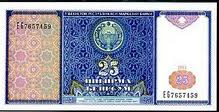|


The som (Uzbek: so‘m in Latin script, сўм in Cyrillic script) is the currency of Uzbekistan in Central Asia. The ISO 4217 currency code is UZS.
Etymology
In the Soviet Union, speakers of Kazakh, Kyrgyz and Uzbek called the ruble the som, and this name appeared written on the back of banknotes, among the texts for the value of the bill in all 15 official languages of the Union. The word som (sometimes transliterated "sum" or "soum") means "pure" in Kyrgyz, Uyghur and Uzbek, as well as in many other Turkic languages. The word implies "pure gold"
First Som
Like other republics of the former Soviet Union, Uzbekistan continued using Soviet/Russian ruble after independence. On July 26, 1993, a new series of Russian ruble was issued and old Soviet/Russian ruble ceased to be legal tender in Russia . Some successor states had their national currencies before the change, some chose to continue using the pre-1993 Soviet/Russian ruble, and some chose to use both the pre-1993 and the new Russian ruble. Tables of modern monetary history: Asia implies that both old and new rubles were used in Uzbekistan.
Uzbekistan replaced the ruble with som at par in on November 15, 1993 . No subdivisions of this som were issued and only banknotes were produced, in denominations of 1, 3, 5, 10, 25, 50, 100, 200, 500, 1000, 5000, and 10000 som. Because it was meant to be a transitional currency, the design was rather simplistic. All notes had the Coat of arms on obverse, and an Islamic architecture on reverse. They only differ in color and value.
Second Som
On July 1, 1994, a second som was introduced at a rate of 1 new som = 1000 old som. This som is subdivided into 100 tiyin. At its introduction, 1 U.S. dollar was equal to 25 som. Currently, the largest denomination of Uzbeki currency, the 1000 som bill, is worth approximately 60 cents U.S., requiring Uzbeks to carry enormous numbers of bills just to carry out grocery shopping and bill payment.
Coins
2 series of coins have been issued for the second som. They can be easily distinguished by the script used for Uzbek. The first series was written in Cyrillic script, while the second series is written in Latin script.
The som (Uzbek: so‘m in Latin script, сўм in Cyrillic script) is the currency of Uzbekistan in Central Asia. The ISO 4217 currency code is UZS.
Etymology
In the Soviet Union, speakers of Kazakh, Kyrgyz and Uzbek called the ruble the som, and this name appeared written on the back of banknotes, among the texts for the value of the bill in all 15 official languages of the Union. The word som (sometimes transliterated "sum" or "soum") means "pure" in Kyrgyz, Uyghur and Uzbek, as well as in many other Turkic languages. The word implies "pure gold"
First Som
Like other republics of the former Soviet Union, Uzbekistan continued using Soviet/Russian ruble after independence. On July 26, 1993, a new series of Russian ruble was issued and old Soviet/Russian ruble ceased to be legal tender in Russia . Some successor states had their national currencies before the change, some chose to continue using the pre-1993 Soviet/Russian ruble, and some chose to use both the pre-1993 and the new Russian ruble. Tables of modern monetary history: Asia implies that both old and new rubles were used in Uzbekistan.
Uzbekistan replaced the ruble with som at par in on November 15, 1993 . No subdivisions of this som were issued and only banknotes were produced, in denominations of 1, 3, 5, 10, 25, 50, 100, 200, 500, 1000, 5000, and 10000 som. Because it was meant to be a transitional currency, the design was rather simplistic. All notes had the Coat of arms on obverse, and an Islamic architecture on reverse. They only differ in color and value.
Second Som
On July 1, 1994, a second som was introduced at a rate of 1 new som = 1000 old som. This som is subdivided into 100 tiyin. At its introduction, 1 U.S. dollar was equal to 25 som. Currently, the largest denomination of Uzbeki currency, the 1000 som bill, is worth approximately 60 cents U.S., requiring Uzbeks to carry enormous numbers of bills just to carry out grocery shopping and bill payment.
Coins
2 series of coins have been issued for the second som. They can be easily distinguished by the script used for Uzbek. The first series was written in Cyrillic script, while the second series is written in Latin script.
The text on this page has been made available under the Creative Commons Attribution-ShareAlike License and Creative Commons Licenses
|
